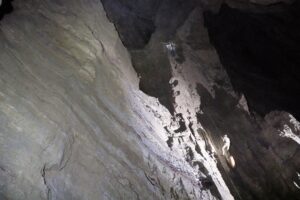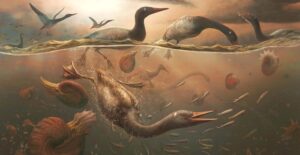We divide the animal kingdom into two camps: warm-blooded (endotherms) and cold-blooded (ectotherms). Warm-blooded animals — today’s mammals and birds — maintain their body temperature without an external heat source like the sun. They use their own metabolism to regulate their body heat.
Meanwhile, cold-blooded animals need an outside heat source to get warm. Today, no mammal is cold-blooded, but it was not always so. But when, how, and why did this change?

Ancient goat skeleton. Photo: Joan Gene/Wikipedia Commons
Researchers believe that they found the general period when mammals shifted from cold-bloodedness to warm-bloodedness. The study, conducted by Romain David and his team, found that “endothermy evolved abruptly during the late Triassic period…[This] correlated with a sharp increase in body temperature (5-9°C) and an expansion of aerobic and anaerobic capacities.”
They discovered this by analyzing the fossilized inner ear functions of mammals from that time. Mammals back then were not like they are now. According to writer Riley Black of Scientific American, mammals of the Permian-Triassic era ate dinosaurs and lived in trees, but were small in size.
The Great Dying
The period called the Permian-Triassic extinction, or the Great Dying, was probably caused by a succession of volcanic eruptions that acidified the atmosphere. It also increased carbon dioxide levels, changed the chemical makeup of our oceans, and raised global temperatures before dropping suddenly.
Over 81% of marine species and 70% of land species perished. Miraculously, some survived. Not only did they adapt their body temperature but wholesale changes in the nervous system and brain also began. It seemed that all the cold-blooded mammals disappeared around this time.
According to the study, the size and shape of the inner ear, particularly the duct system, shows us when this change occurred. This part of a mammal, particularly an inner ear fluid called endolymph, is influenced by temperature. The warmer the temperature, the smaller the ear. The colder the temperature, the larger.
Supposedly, warm-bloodedness in mammals emerged around 252 million years ago, during this mass extinction event. The climate changed drastically, which has challenged scientists’ preconceived notions that this cold/warm-blooded evolution happened gradually.

Dinosaurs lived alongside these cold-blooded mammals. Photo: SAHACHATZ/Shutterstock
One cold-blooded mammal survived
Until 3,000 years ago, only one cold-blooded mammal remained. This was Myotragus balearicus, a type of goat that had been cold-blooded for eons. It used to roam the Spanish island of Mallorca. Skeletal remains show that it only stood 45cm tall. All parts of its body were dwarfed, from its stubby limbs to its brain size. Supposedly, this goat’s bone structure and tissue were similar to — what else? — reptiles. This caused the goat to grow slowly and even move sluggishly.
Scientists believe this similarity to reptiles was a survival and adaptability mechanism. Mallorca was isolated from the mainland and lacked both abundant food and external threats. This allowed the goats to have a more laid-back way of life. Since it did not have to struggle as much as other species, it didn’t exert much energy.
Sadly, after thriving for 5.2 million years, this one cold-blooded relic went extinct from human activity. And thus, our mammals became fully warm-blooded afterward.






